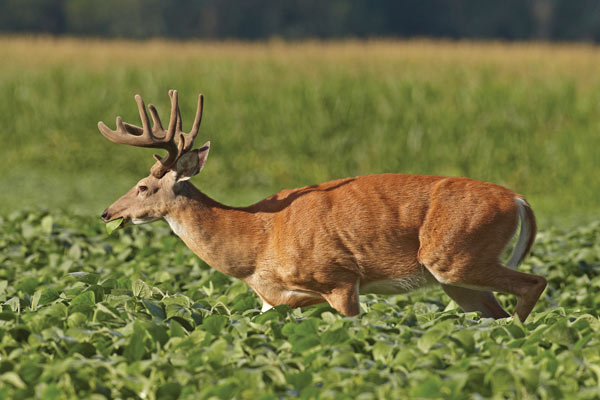March 17, 2015
By Gordon Whittington
 Unless you pay zero attention to environmental coverage in the media, you know there's a war going on over our food supply.
Unless you pay zero attention to environmental coverage in the media, you know there's a war going on over our food supply.
On one side stand many in the agricultural community. On the other stand critics who say today's bountiful crops will prove the death of us all. And at the center of this debate lies a single question: Are there major health risks associated with certain crops and specific agricultural chemicals used to treat them?
To date, an ironclad answer has proved elusive. And you won't find one here. But the truth is worth pursuing, and for reasons that go beyond the health of humans, livestock or pets. Some of the most heavily modified crops, including corn, soybeans and alfalfa, also are eagerly eaten by whitetails.
It's prudent, then, to ask if the farming boom that helped the species expand now might be threatening its health.
Advertisement
Tweaking Plants
Over several millennia, a handful of the world's native plants became favorite foods of humans and livestock. Thus, through selective breeding they received the bulk of effort to make them more productive and nutritious. Among these crops are corn, soybeans, potatoes, alfalfa, canola and cereal grains, including wheat, oats, rye, barley and rice. Today, these plants or their byproducts are found in most commercial food products or are fed to livestock whose meat we eat.
The push for higher yields at lower cost also fueled the development of herbicides, insecticides and fungicides. But only recently has crop science moved into the realm of "inventing" genetically modified organisms (GMOs): those whose genes have been artificially manipulated to have a productive advantage, especially in concert with chemical treatments. Genetic engineering is creating combinations of plant, animal, bacterial and viral genes not occurring in nature or through traditional crossbreeding.
Advertisement
Most common, to date, are GMOs "built" to withstand direct application of herbicides. And one herbicide in particular — glyphosate — catches most of the fire from critics who claim it's not nearly as benign as is claimed by Monsanto, the company that introduced it to consumers in 1974. This broad-spectrum, non-selective systemic herbicide works by inhibiting an enzyme involved in the synthesis of amino acids in growing plants.
Even if you don't know "glyphosate," no doubt you've heard of the most popular product containing it: Roundup. Glyphosate is the active ingredient in this herbicide, which you likely use to spray weeds in your yard — and perhaps in your food plots. With "Roundup Ready" (RR) crop varieties, glyphosate can be used to kill many annuals and perennials, including grasses, sedges, broad-leaved weeds and woody plants, without harming the crop.
In North America there now are millions of acres of GMO plantings. With several of the world's largest corporations deep into producing these seeds and related chemicals, it's safe to assume GMOs won't be banned tomorrow. Thus, if the deer you hunt have been feeding on such crops and/or other plants treated with glyphosate, expect that to continue — unless the people controlling the land decide otherwise.
Growing Concerns
A North Carolina friend recently told me deer had all but quit using a local bean field since the farmer switched to RR beans. Now, he says, most feed in a nearby clover pasture instead.
Do those deer know something science doesn't? It's hard to say. Depending on where, when, how and by whom a given study was done, reported GMO impacts range from zero to catastrophic.
Most research has focused on humans and livestock. But veteran plant pathologist Dr. Don Huber, professor emeritus at Purdue University, told me Montana's Judy Hoy has spent years studying pesticide effects on whitetails and other wild ungulates. I later learned that Dr. Diana Henshel at Indiana University also has given Judy's work a positive review. With those endorsements out of the way, here's what Judy revealed to me, verbatim:
"The use of Roundup on Roundup Ready crops increased astronomically in 1994 and even more in 2005 and 2006 on with the release of genetically modified (GMO) Roundup Ready seeds for multiple crops. What appears to cause even worse symptoms, especially to animal fetuses, the formulation for glyphosate and other commonly used herbicides was changed to a salt formulation. These formulations have been applied since 2005.
"Even more alarming, glyphosate (Roundup) has been shown to act synergistically with chlorothalonil (Bravo), a fungicide with cyanide as part of its molecule. Simultaneous exposure has been shown to cause much worse damage to cellular functions than either alone. Millions of pounds of Bravo have been used to combat potato blight each year in potato-growing states in summer since 1994.
"Both Bravo and Roundup cause significant disruption to thyroid hormone functions, especially in developing fetuses. Hypothyroidism in adults, especially does, can be quite obvious. Failure to thrive, extreme emaciation and failure to gain weight, failure to produce fawns, hair loss and/or slow growth of new hair in spring and fall and weak pasterns resulting in hoof malformations are some of the most common.

"The use of Roundup on Roundup Ready crops increased astronomically in 1994 and even more in 2005 and 2006 on with the release of genetically modified (GMO) Roundup Ready seeds for multiple crops."
"When glyphosate is ingested, it chelates many minerals, including manganese, calcium, phosphate, copper, iron, zinc, nickel and others. It also chelates the minerals in the plants on which it is applied or on which it lands in rain and snow. The consequent deficiencies of those minerals cause fetal hypothyroidism and a wide variety of birth defects.
"Manganese deficiency alone has been shown by multiple studies to cause brachygnathia superior (underbite) in ruminants. Glyphosate also disrupts Vitamin A and immune system functions, as well as being an antibiotic. For an ungulate to constantly ingest an antibiotic has adverse affects on its gut flora (microbes that aid in digestion).
"I am a wildlife rehabilitator, and my husband is a biologist by education, who was a game warden for Montana Department of Fish, Wildlife and Parks and is now retired. We live in western Montana, in Ravalli County, where our studies on birth defects on wild ruminants, especially white-tailed deer, were done.
"As a game warden, my husband retrieved many accident-killed big-game animals, primarily white-tailed deer, from roadsides and yards, and I examined the carcasses prior to disposal. I also cared for newborn wild ruminants. Thus, we examined hundreds of white-tailed deer prior to and after 1995.
"We observed that, beginning in spring of 1995 and continuing through 2014, many individuals of white-tailed deer fawns were born with one or more birth defects consistent with mineral deficiencies and thyroid hormone disruption. In 1996, I began documenting the bite, the size of the deer and the size of the male genitalia with measurements and photos. I also found the sex ratio on the white-tailed deer skewed highly in favor of males at around 60M/40F, especially between 1995 and 2002.
"With so many more males born than females, there was a direct and almost instant effect on recruitment rates in the affected population. The hunters were very happy with large numbers of buck deer to harvest, until the entire deer population began declining. The mule deer fawns were affected even worse than the white-tailed deer fawns, so the mule deer population is now in serious trouble in some states.
"On male fawns, the most common birth defects are genital hypoplasia and a misaligned scrotum formed with the left testis directly forward of the right. The most severe reproductive malformations, such as ectopic testes (between the body wall and the skin) affect a buck's ability to reproduce, but do not cause mortality. Many of the other birth defects cause direct mortality in the young, in turn causing observable declines in the most affected populations.
"The most common birth defect on both sexes of fawns are underbite as a result of underdevelopment of the upper facial bones and sometimes the skull, in addition to wider-than- normal, doglegged lower incisors. Underbite significantly affects a grazing animal's ability to bite off foliage and causes malnutrition. Even mild underbite can affect winter survival of fawns and the survival of the fetuses of pregnant does, if there is deep snow and cold temperatures.
"Other less common birth defects we observed were crooked legs, missing digits, contracted tendons, weak pasterns, eye malformations and herniated umbilicus. Many white-tailed deer fawns I necropsied had underdeveloped and/or damaged thymus, enlarged right heart ventricle and damaged lungs, all of which can contribute to early mortality. All birth defects found on the deer and other animals have been shown by many studies to be caused by fetal hypothyroidism.

In North America there now are millions of acres of GMO plantings. With several of the world's largest corporations deep into producing these seeds and related chemicals, it's safe to assume GMOs won't be banned tomorrow.
"Even if the young-of-the-year female fawns with underbite or enlarged heart ventricles survive their first two winters and are subsequently bred, their ability to produce viable young can be severely compromised, because their fawns often have even worse birth defects.
"It quickly became obvious that the newborns of other mammals, which eat mainly plants or seeds, especially wild and domestic herbivores, rodents and many bird species, were also being born with some or all of the same birth defects. With so many different animals being affected, one or more environmental toxins were suspected as the cause. The question was, what was suddenly used in high-enough amounts to cause such widespread symptoms of fetal hypothyroidism?
"Based on timing and symptoms of exposure, the culprits at this time appear to be Roundup and Bravo acting synergistically. Tested animals like dairy cows that eat GMO crops or other plants with Roundup on them have fairly high levels of glyphosate in their urine and/or milk. White-tailed deer eat on fields planted with GMO crops, especially alfalfa. With glyphosate in white-tailed deer milk, the mineral chelating effect on their fawns could be significant and at the least, affect their growth and at worst cause them to die. These are just a few of the many ways GMO crops sprayed with Roundup can affect white-tailed deer and other wild ungulate populations."
So what's the take-home message?
"I would strongly recommend not using GMO crops for food plots, and of course, no pesticides should be sprayed on food intended for wildlife," Dr. Hoy advised. "Farmers who care about today's children and all future generations of animals and people would be wise to immediately switch to farming organically. If that is not possible, they should not use pesticides like Roundup, Chlorothalonil, Neonics, 2,4-D, Atrazine and others that have been shown to be the most deadly to animals of all kinds, from beneficial insects to larger mammals like white-tailed deer."
In Conclusion
Those of us here at NAW grew up working with crops and livestock and of course remain avid food plotters. As such, we acknowledge the many ways in which agriculture has benefited millions of us hunters and continues to do so.
Apparently no state or provincial wildlife agency has blamed GMOs or farm chemicals for a decline in whitetail numbers, though the drop began roughly when such products came into widespread use. Still, there's reason to closely follow the story of GMOs and chemicals used to treat our crops. Until science offers clear proof of their safety, it seems wise for deer managers to proceed with caution.
"Why use GMOs in food plots in the first place?" asks Dr. James C. Kroll, director of the Institute for White-tailed Deer Management & Research. "Weeds in food plots are generally a good thing. Some folks are so anal about having pure crops that they go to great lengths to keep them weed-free. I like weeds in plots and only use herbicides when absolutely necessary."
Have a GMO/glyphosate experience of your own to share? Please email us at: whitetail@imoutdoors.com.


